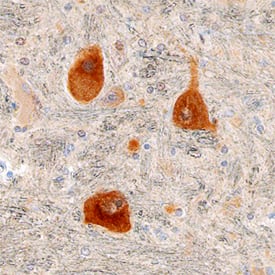Human/Mouse/Rat DGK-epsilon Antibody
R&D Systems, part of Bio-Techne | Catalog # MAB5125

Key Product Details
Species Reactivity
Human, Mouse, Rat
Applications
Immunohistochemistry, Western Blot
Label
Unconjugated
Antibody Source
Monoclonal Mouse IgG2B Clone # 670914
Product Specifications
Immunogen
E. coli-derived recombinant human DGK-epsilon
Asn314-Arg435
Accession # P52429
Asn314-Arg435
Accession # P52429
Specificity
Detects human DGK-epsilon in direct ELISAs and human, mouse and rat DGK-epsilon in Western blots. In Western blots, approximately 10-50% cross-reactivity with recombinant human DGK zeta, eta, iota, alpha, theta, gamma, kappa, delta, and beta is observed.
Clonality
Monoclonal
Host
Mouse
Isotype
IgG2B
Scientific Data Images for Human/Mouse/Rat DGK-epsilon Antibody
Detection of Human, Mouse, and Rat DGK‑ epsilon by Western Blot.
Western blot shows lysates of HeLa human cervical epithelial carcinoma cell line, L1.2 mouse pro-B cell line, L6 rat myoblast cell line, and Nb2-11 rat lymphoma cell line. PVDF membrane was probed with 1 µg/mL of Mouse Anti-Human DGK-e Monoclonal Antibody (Catalog # MAB5125) followed by HRP-conjugated Anti-Mouse IgG Secondary Antibody (Catalog # HAF007). A specific band was detected for DGK-e at approximately 64 kDa (as indicated). This experiment was conducted under reducing conditions and using Immunoblot Buffer Group 1.DGK‑ epsilon in Human Brain.
DGK-e was detected in immersion fixed paraffin-embedded sections of human brain (medulla) using Mouse Anti-Human DGK-e Monoclonal Antibody (Catalog # MAB5125) at 15 µg/mL overnight at 4 °C. Before incubation with the primary antibody, tissue was subjected to heat-induced epitope retrieval using Antigen Retrieval Reagent-Basic (Catalog # CTS013). Tissue was stained using the Anti-Mouse HRP-DAB Cell & Tissue Staining Kit (brown; Catalog # CTS002) and counterstained with hematoxylin (blue). Specific staining was localized to neurons. This application has not yet been tested in mouse or rat samples. View our protocol for Chromogenic IHC Staining of Paraffin-embedded Tissue Sections.Applications for Human/Mouse/Rat DGK-epsilon Antibody
Application
Recommended Usage
Immunohistochemistry
8-25 µg/mL
Sample: Immersion fixed paraffin-embedded sections of human brain (medulla)
Sample: Immersion fixed paraffin-embedded sections of human brain (medulla)
Western Blot
1 µg/mL
Sample: HeLa human cervical epithelial carcinoma cell line, L1.2 mouse pro-B cell line, L6 rat myoblast cell line, and Nb2‑11 rat lymphoma cell line
Sample: HeLa human cervical epithelial carcinoma cell line, L1.2 mouse pro-B cell line, L6 rat myoblast cell line, and Nb2‑11 rat lymphoma cell line
Formulation, Preparation, and Storage
Purification
Protein A or G purified from hybridoma culture supernatant
Reconstitution
Sterile PBS to a final concentration of 0.5 mg/mL. For liquid material, refer to CoA for concentration.
Formulation
Lyophilized from a 0.2 μm filtered solution in PBS with Trehalose. *Small pack size (SP) is supplied either lyophilized or as a 0.2 µm filtered solution in PBS.
Shipping
Lyophilized product is shipped at ambient temperature. Liquid small pack size (-SP) is shipped with polar packs. Upon receipt, store immediately at the temperature recommended below.
Stability & Storage
Use a manual defrost freezer and avoid repeated freeze-thaw cycles.
- 12 months from date of receipt, -20 to -70 °C as supplied.
- 1 month, 2 to 8 °C under sterile conditions after reconstitution.
- 6 months, -20 to -70 °C under sterile conditions after reconstitution.
Background: DGK-epsilon
Long Name
Diacylglycerol Kinase, epsilon 64kDa
Alternate Names
DAGK5, DAGK6, DGKE, DGKepsilon
Gene Symbol
DGKE
UniProt
Additional DGK-epsilon Products
Product Documents for Human/Mouse/Rat DGK-epsilon Antibody
Product Specific Notices for Human/Mouse/Rat DGK-epsilon Antibody
For research use only
